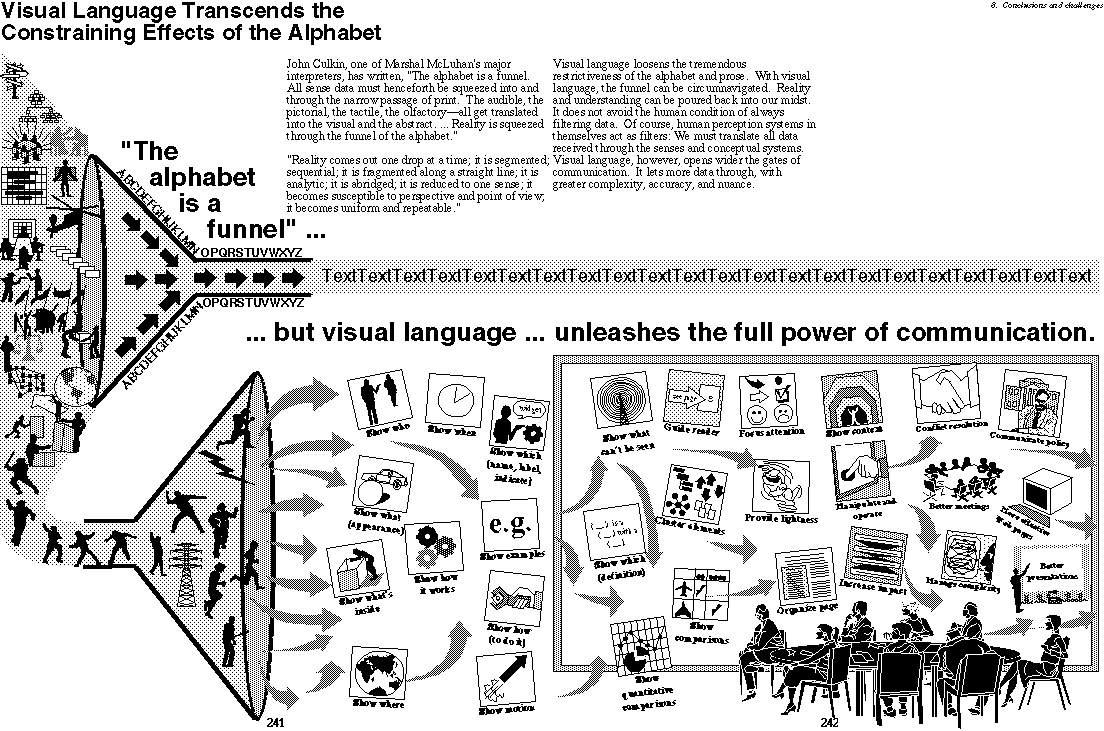It’s only through wandering that any of us ever get a solid sense of where we want to go.
(Scott McCloud, Making Comics, p. 238)
Seems like I wander a lot. It’s nice to have this validation!

It’s only through wandering that any of us ever get a solid sense of where we want to go.
(Scott McCloud, Making Comics, p. 238)
Seems like I wander a lot. It’s nice to have this validation!


Robert Horn’s Visual Language: Global Communication for the 21st Century has just been republished, by Xplane, “the visual thinking company”! It’s been out of print for at least 4 years. The best way to get a feel for it is to look at some of the sample pages, and read about it on Horn’s site. It’s written in visual language (which Horn defines as “the tight integration of words and visual elements”) and arranged in two-page spreads.
I could write a description and review, but that’s really going against the spirit of visual communication! That idea is succinctly captured in this sample spread: The reason I’m so excited about it is because I believe visual communication has enormous potential to solve problems through improving understanding between individuals, groups, even nations, because, compared to the serial nature of text or spoken words,
The reason I’m so excited about it is because I believe visual communication has enormous potential to solve problems through improving understanding between individuals, groups, even nations, because, compared to the serial nature of text or spoken words,
“Visual language opens wider the gates of communication. It lets more data through, with greater complexity, accuracy, and nuance.”
(p. 242) If more people start to consciously use visual language, more people will adopt it as their “native” language, and we will all have an easier time understanding each other. This book is many books in one. It is practical, with a lot of examples, plus a lot of reference information, history, and research citations. It must have been a huge amount of work, so I’m glad it has been republished so more people can benefit from that investment.
If you want to read more about it, check out the announcement on Dave Gray’s CommunicationNation blog. And for more background, see Horn’s websites here and here.
If you want to buy it, you can order it here.
For a terrific example of crisp, clear, concise visual communication with a touch of whimsy, check out Xplane’s website.
Here’s a description of an economics simulation made visible in a virtual reality room:
A crimson comet, at ten o’clock, just above the horizon, paints an upturn in third-quarter commodities. A rose of starbursts means stubborn unemployment.
Hidden relations spill out, suddenly obvious, from a twist of the tabular data. Tendencies float like lanterns across the face of a summer’s night.
…
In this room of open prediction, facts flash like a headland light. The search flares burst around you where you stand, lost in an informational fantasia: tangled graphical dances of devaluation, industrial upheaval, protective tariffs, striking shipbuilders, the G7, Paraguay, Kabul. The sweep of the digital – now beyond its inventors’ collective ability to index – falls back, cowed by the sprawl of the runaway analog. Five billion parallel processors, each a world economy, update, revise, negate one another, capsize the simulation, pumping their dissatisfied gross national product beyond the reach of number.
(From Plowing the Dark by Richard Powers)
This is from a book I’m reading in which the author imagines the power of visualization which may soon be available through further advances in computing technology. The beauty of this is that it is a NOVEL, not a dry technology forecast, or glossy marketing brochure. The power of storytelling triggers our emotional and imaginative response, allowing us to connect with this future as a reality. It reminds me of Neal Stephenson’s Snow Crash, in which people interacted in the online “metaverse” via “avatar” personas – a vision of Second Life (“SecondLife is a 3D online digital world imagined, created, & owned by its residents”). While Plowing the Dark is strictly in prose (no graphics), it paints a vivid picture of the power of visual representation to extend our awareness and understanding. I’m not far enough into it to know whether he explores the potential of the technology to further our wisdom, or explores its downsides as well as its benefits. I suspect he examines both sides, as there was already an example of one programmer developing a black eye from a “collision” with a virtual branch!
This book illustrates the principle behind scenario building. A vivid, multi-sensory, plausible scenario causes us to feel the impact of a situation, motivating us to take steps to bring it about, in the case of a desirable outcome, or prevent its occurrence, in the case of an undesirable future.
By the way, you don’t have to be a computer geek to enjoy this book. The technical details are described at a high level as an artist character seeks to understand her role in the project, and to contribute to it, and to explain the excitement and dedication (or obsession!) of her fellow researchers.
The bottom line: Whether through story, or scenarios, or graphical representation, visualization is extremely powerful for an individual or group to create a desired outcome, whether that is a new product, a solution to a tough problem, or a better world.